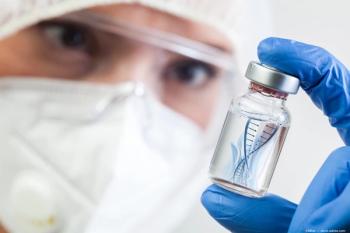
- Ophthalmology Times: February 15, 2021
- Volume 46
- Issue 3
The untapped potential of cell and gene therapy as treatment option
Investigators continue to break new ground, giving hope to patients, physicians.
Excitement took wing in the scientific community in the early 1990s, when the first-ever gene therapy trial showed significant success, only to crash at the end of the decade with a patient’s tragic death.
Twenty years later, the excitement is back and greater than before. Although safety remains a concern, investigators are breaking ground in cell and
Related:
“We can absolutely cut the number of cancer deaths down so that one day in our lifetimes it can be a rare thing for people to die of cancer,” said Patrick Hwu, MD, president and CEO of Moffitt Cancer Center in Florida and among gene therapy’s pioneers. “It still may happen here and there, but it’ll be kind of like people dying of pneumonia. It is like, ‘He died of pneumonia? That is kind of weird.’ I think cancer can be the same way.”
The excitement returned in spades in 2017 when the FDA signed off on a gene-therapy drug for the first time, approving the chimeric antigen receptor (CAR) T-cell treatment tisagenlecleucel (Kymriah; Novartis) for the treatment of Bcell precursor acute lymphoblastic leukemia. At last, scientists had devised a way to reprogram a person’s own T cells to attack tumor cells.
A new frontier
“We’re entering a new frontier,” said Scott Gottlieb, MD, then the FDA Commissioner, in announcing the groundbreaking approval.
Gottlieb wasn’t exaggerating. The growth in CAR T-cell treatments is exploding. Although only a handful of cell and gene therapies are on the market, the FDA predicted in 2019 that it will receive more than 200 investigational new drug applications per year for cell and gene therapies, and that by 2025, it expects to have accelerated to 10 to 20 cell and gene therapy approvals per year.
“Essentially, you can kill any cancer cell that has an antigen that is recognized by the immune cell,” Hwu said. “The key to curing every single cancer, which is our goal, is to have receptors that can recognize the tumor but don’t recognize the normal cells.”
Receptors recognizing and then attacking normal cells is what can cause toxicity.Cell therapy involves cultivating or modifying immune cells outside the body before injecting them into the patient.
Related:
Cells may be autologous (self-provided) or allogeneic (donor-provided); they include hematopoietic stem cells and adult and embryonic stem cells. Gene therapy modifies or manipulates cell expression. There is considerable overlap between the 2 disciplines.
Juliette Hordeaux, PhD, senior director of translational research for the University of Pennsylvania’s gene therapy program, is cautious about the FDA’s predictions, saying she would be “thrilled” with 5 cell and/or gene therapy approvals annually.
“For monogenic diseases, there are only a certain number of mutations, and then we’ll plateau until we reach a stage where we can go after more common diseases,” Hordeaux said.
“Safety has been the main brake around adeno-associated virus vector (AAV) gene therapy,” added Hordeaux, whose hospital’s program has the institutional memory of both Jesse Gelsinger’s tragic death during a 1999 gene therapy trial as well as breakthroughs by Carl June, MD, and others in CAR T-cell therapy. “Sometimes there are unexpected toxicity [events] in trials.…I think figuring out ways to make gene therapy safer is going to be the next goal before we can even envision many more drugs approved.”
In total, 3 CAR T-cell therapies are now on the market, all targeting the CD19 antigen. Tisagenlecleucel was the first. Gilead Sciences received approval in October 2017 for axicabtagene ciloleucel (axi-cel; Yescarta), a CAR T-cell therapy for adults with large B-cell non-Hodgkin lymphoma.
Kite Pharma, a subsidiary of Gilead, received an accelerated approval in July 2020 for brexucabtagene autoleucel (Tecartus) for adults with relapsed or refractory mantle cell lymphoma.
Related:
Another CD19-directed therapy under FDA review, for relapsed/refractory large B-cell lymphoma, is lisocabtagene maraleucel (liso-cel; JCAR017; Bristol Myers Squibb). Idecabtagene vicleucel (ide-cel; bb2121; Bristol Myers Squibb) is under priority FDA review, with a decision expected by March 31, 2021.
The biologics license application seeks approval for ide-cel, a Bcell maturation antigen–directed CAR therapy, to treat adult patients with multiple myeloma who have received at least 3 prior therapies.1
The number of clinical trials evaluating CAR T-cell therapies has risen sharply since 2015, when investigators counted a total of 78 studies registered on the ClinicalTrials.gov website. In June 2020, the site listed 671 trials, including 357 registered in China, 256 in the United States, and 58 in other countries.2
Natural killer (NK) cells are the research focus of Dean Lee, MD, PhD, a physician in the Division of Hematology and Oncology at Nationwide Children’s Hospital. He developed a method for consistent, robust expansion of highly active clinical-grade NK cells that enables repeated delivery of large cell doses for improved efficacy.
This finding led to several first-in-human clinical trials evaluating adoptive immunotherapy with expanded NK cells under an FDA Investigational New Drug application.
He is developing both genetic and nongenetic methods to improve tumor targeting and tissue homing of NK cells. His efforts are geared toward pediatric sarcomas.
“The biggest emphasis over the past 20 to 25 years has been cell therapy for cancer, talking about trying to transfer a specific part of the immune system for cells,” said Lee, who is also the director of the Cellular Therapy and Cancer Immunology Program at Nationwide Children’s Hospital at The Ohio State University Comprehensive Cancer Center – Arthur G. James Cancer Hospital and Richard J. Solove Research Institute.
Related:
The pivot toward treating COVID-19 and other diseases
However, Lee said, NKs have wider potential. “This is kind of a natural swing back. Now that we know we can grow them, we can reengineer them against infectious disease targets and use them in that [space],” he said.
Lee is part of a coronavirus disease 2019 (COVID-19) clinical trial, partnering with Kiadis, for off-the-shelf K-NK cells using Kiadis’ proprietary platforms. Such treatment would be a postexposure preemptive therapy for treating COVID-19.
Lee said the pivot toward treating COVID-19 with cell therapy was because “some of the very early reports on immune responses to coronavirus, both original [SARS-CoV-2] and the new [mutation], seem to implicate that those who did poorly [overall] had poorly functioning NK cells.”
The revolutionary gene editing tool CRISPR is making its initial impact in clinical trials outside the cancer area. Its developers, Jennifer Doudna, PhD, and Emmanuelle Charpentier, PhD, won the Nobel Prize in Chemistry 2020.
For patients with sickle cell disease (SCD), CRISPR was used to reengineer bone marrow cells to produce fetal hemoglobin, with the hope that the protein would turn deformed red blood cells into healthy ones.
National Public Radio did a story on one patient who, so far, thanks to CRISPR, has been liberated from the attacks of SCD that typically have sent her to the hospital, as well from the need for blood transfusions.3
Related:
“It is a miracle, you know?” the patient, Victoria Gray of Forest, Mississippi, told NPR. Shewas among 10 patients with SCD or transfusion-dependent beta-thalassemia treated with promising results, as reported by the New England Journal of Medicine.4
Stephen Gottschalk, MD, chair of the department of bone marrow transplantation and cellular therapy at St Jude Children’s Research Hospital, said, “There’s a lot of activity to really explore these therapies with diseases that are much more common than cancer.”
Animal models use T cells to reverse cardiac fibrosis, for instance, Gottschalk said. Using T cells to reverse pathologies associated with senescence is also being studied.
Hordeaux said she foresees AAV being used more widely to transmit neurons to attack neurodegenerative diseases because he neurons are easily transduced by AAV naturally.
Logistical issues
Speed is of the essence, as delays can be the difference between life and death, but the approval process takes time. The process of working out all kinks in manufacturing also remains a challenge.
Related:
Rapid production is difficult, too, because of the necessary customization of doses and the need to ensure a safe and effective transfer of cells from the patient to the manufacturing center and back into the patient.5
Other factors that can slow down launches include insurance coverage, site certification, staff training, reimbursement, and patient identification.
“CAR T, I think, will become part of the standard of care,” Gottschalk said. “The question is how to best get that accomplished. To address the tribulations of some autologous products, a lot of groups are working with off-the-shelf products to get around some of the manufacturing bottlenecks.”
References
1. Bristol Myers Squibb provides regulatory update on lisocabtagene maraleucel (liso-cel). News release. Bristol Myers Squibb; November 16, 2020. Accessed January 11, 2021. [Au: please add]
2. Wei J, Guo Y, Wang Y. et al. Clinical development of CAR T cell therapy in China: 2020 update. Cell Mol Immunol. Published online September 30, 2020. doi:10.1038/s41423-020-00555-x
3. Stein R. CRISPR for sickle cell diseases shows promise in early test. Public Radio East. November 19, 2019. Accessed January 11, 2021. [Au: please add]
4. Esrick EB, Lehmann LE, Biffi A, et al. Post-transcriptional genetic silencing of BCL11A to treat sickle cell disease. N Engl J Med. Published online December 5, 2020. doi:10.1056/NEJMoa2029392
5. Yednak C. The gene therapy race. PwC. February 5, 2020. Accessed January 11, 2021.
Articles in this issue
almost 5 years ago
Uveitis: A leading, underestimated cause of visual morbidity in patientsalmost 5 years ago
More than meets the eye with corneal dystrophiesalmost 5 years ago
ADVM-022 offers sustained anatomic improvements in wet AMDalmost 5 years ago
Study targets strategies for CI-DMEalmost 5 years ago
Visualization with en face OCT offers value for ophthalmologistsalmost 5 years ago
IOLs offer great vision, low risk profile for myopiaalmost 5 years ago
A menu of glaucoma treatments includes options to fit all scenariosalmost 5 years ago
Managing strabismus after retinal detachment surgeryalmost 5 years ago
Investigators zoom in on future of dry eye treatmentNewsletter
Don’t miss out—get Ophthalmology Times updates on the latest clinical advancements and expert interviews, straight to your inbox.













































